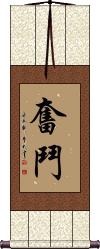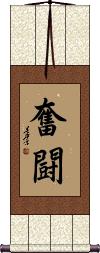Many custom options...
And formats...

Not what you want?
Try other similar-meaning words, fewer words, or just one word.
Feel free to email me with your request. If it's easy, I'll translate it for free and add it to this database of calligraphy for you.
Strive Struggle in Chinese / Japanese...
Buy a Strive Struggle calligraphy wall scroll here!
Personalize your custom “Strive Struggle” project by clicking the button next to your favorite “Strive Struggle” title below...
Strive / Struggle
奮鬥 means strive (as in to put great effort into something or a cause).
It can also be translated as a struggle.
![]() The second character of this word can also be written as shown to the right. Yes.
it’s
very different. If you want this alternate version, just let us know when you place your order (in the special instructions).
The second character of this word can also be written as shown to the right. Yes.
it’s
very different. If you want this alternate version, just let us know when you place your order (in the special instructions).
Strive / Struggle
Not the results for strive struggle that you were looking for?
Below are some entries from our dictionary that may match your strive struggle search...
| Characters If shown, 2nd row is Simp. Chinese |
Pronunciation Romanization |
Simple Dictionary Definition |
掙 挣 see styles |
zhèng zheng4 cheng |
to struggle to get free; to strive to acquire; to make (money) |
奮鬥 奋斗 see styles |
fèn dòu fen4 dou4 fen tou |
to strive; to struggle |
爭衡 争衡 see styles |
zhēng héng zheng1 heng2 cheng heng |
to struggle for mastery; to strive for supremacy |
足掻く see styles |
agaku あがく |
(v5k,vi) (1) (kana only) to paw (at) the ground; (v5k,vi) (2) (kana only) to struggle (using one's arms and legs); to flounder; to flail about; (v5k,vi) (3) (kana only) to struggle (to escape an adverse situation); to strive; to make every effort |
Variations: |
agaku あがく |
(v5k,vi) (1) (kana only) to paw (at) the ground; (v5k,vi) (2) (kana only) to struggle (using one's arms and legs); to flounder; to flail about; (v5k,vi) (3) (kana only) to struggle (to escape an adverse situation); to strive; to make every effort |
Variations: |
agaku あがく |
(v5k,vi) (1) (kana only) to paw (at) the ground; (v5k,vi) (2) (kana only) to struggle (using one's arms and legs); to flounder; to flail about; (v5k,vi) (3) (kana only) to struggle (to escape an adverse situation); to strive; to make every effort |
The following table may be helpful for those studying Chinese or Japanese...
| Title | Characters | Romaji (Romanized Japanese) | Various forms of Romanized Chinese | |
| Strive Struggle | 奮鬥 / 奮斗 奋斗 / 奋鬥 | fèn dòu / fen4 dou4 / fen dou / fendou | fen tou / fentou | |
| Strive Struggle | 奮闘 / 奮鬥 奋斗 / 奋鬥 | fun tou / funtou / fun to | ||
| In some entries above you will see that characters have different versions above and below a line. In these cases, the characters above the line are Traditional Chinese, while the ones below are Simplified Chinese. | ||||
Successful Chinese Character and Japanese Kanji calligraphy searches within the last few hours...





